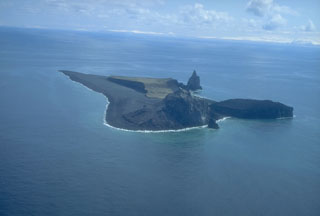Report on Bogoslof (United States) — 8 February-14 February 2017
Smithsonian Institution / US Geological Survey
Weekly Volcanic Activity Report, 8 February-14 February 2017
Managing Editor: Sally Sennert.
Please cite this report as:
Global Volcanism Program, 2017. Report on Bogoslof (United States) (Sennert, S, ed.). Weekly Volcanic Activity Report, 8 February-14 February 2017. Smithsonian Institution and US Geological Survey.
Bogoslof
United States
53.93°N, 168.03°W; summit elev. 150 m
All times are local (unless otherwise noted)
AVO reported that during 8-12 and 14 February cloud cover prevented satellite views of Bogoslof; no other data indicated eruptive activity. At 0724 on 13 February seismicity significantly increased, prompting AVO to raise the Aviation Color Code (ACC) to Red and the Volcano Alert Level (VAL) to Warning. Satellite images acquired through 0930 showed no ash emissions above the 3 km (10,000 ft) a.s.l. cloud deck, and no lightning was detected. AVO concluded that, despite the intensity of seismic activity, a significant ash emission was not produced during this event; the ACC was lowered to Orange and the VAL was lowered to Watch.
Geological Summary. Bogoslof is the emergent summit of a submarine volcano that lies 40 km N of the main Aleutian arc. It rises 1,500 m above the Bering Sea floor. Repeated construction and destruction of lava domes at different locations during historical time has greatly modified the appearance of this "Jack-in-the-Box" volcano and has introduced a confusing nomenclature applied during frequent visits by exploring expeditions. The present triangular-shaped, 0.75 x 2 km island consists of remnants of lava domes emplaced from 1796 to 1992. Castle Rock (Old Bogoslof) is a steep-sided pinnacle that is a remnant of a spine from the 1796 eruption. The small Fire Island (New Bogoslof), about 600 m NW of Bogoslof Island, is a remnant of a lava dome formed in 1883.
Source: US Geological Survey Alaska Volcano Observatory (AVO)

